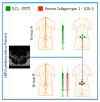Combined Oxygen-Ozone and Porcine Injectable Collagen Therapies Boosting Efficacy in Low Back Pain and Disability
- PMID: 39518378
- PMCID: PMC11545265
- DOI: 10.3390/diagnostics14212411
Combined Oxygen-Ozone and Porcine Injectable Collagen Therapies Boosting Efficacy in Low Back Pain and Disability
Abstract
Background/Objectives: Intervertebral disc degeneration is the most common cause of low back pain (LBP), and lumbosciatica is a major challenge to healthcare systems worldwide. For years, ozone therapy has been used with excellent results in intervertebral disc disease and in patients with LBP. In vitro studies have demonstrated the positive action of porcine collagen in extracellular matrix remodeling and homeostasis. These tissue changes, associated with LBP, may suggest an indication for combined ozone/collagen treatment in patients with LBP. However, no studies have been reported regarding this combination of treatments. Methods: The present work compared retrospective data of two treatment groups (each of 10 LBP patients): (A) oxygen-ozone therapy (OOT) vs. (B) OOT plus porcine collagen type 1 injections (COL I). Pain intensity and physiological function were assessed by the numerical rating scale (NSR) method. The Roland-Morris questionnaire was used to assess disability. Patient data were acquired before, during, and at the six-month follow-up. Significant differences were assessed by ANOVA and Student's t-test. Results: The analyses revealed significant statistical differences comparing the two arms, where the (OOT+COL I) treatment demonstrated a booster efficacy in pain (a reduction of 62% vs. 35%), while the questionnaire revealed a reduction in disability (70% vs. 31%). Conclusions: Therefore, this combination therapy (oxygen-ozone plus porcine injectable collagen) might be a promising approach for the management of patients with LBP.
Keywords: Roland–Morris questionnaire; combination therapy; low back pain; low back pain clinical management; numerical classification scale; oxygen–ozone therapy; porcine collagen injection; porcine collagen type 1.
Conflict of interest statement
The authors declare no conflicts of interest.
Figures




References
-
- Costa T., Linhares D., Ribeiro da Silva M., Neves N. Ozone Therapy for Low Back Pain. A Systematic Review. Acta Reumatol. Port. 2018;43:172–181. - PubMed
-
- Paoloni M., Di Sante L., Cacchio A., Apuzzo D., Marotta S., Razzano M., Franzini M., Santilli V. Intramuscular Oxygen-Ozone Therapy in the Treatment of Acute Back Pain With Lumbar Disc Herniation: A Multicenter, Randomized, Double-Blind, Clinical Trial of Active and Simulated Lumbar Paravertebral Injection. Spine. 2009;34:1337–1344. doi: 10.1097/BRS.0b013e3181a3c18d. - DOI - PubMed
LinkOut - more resources
Full Text Sources
Miscellaneous

